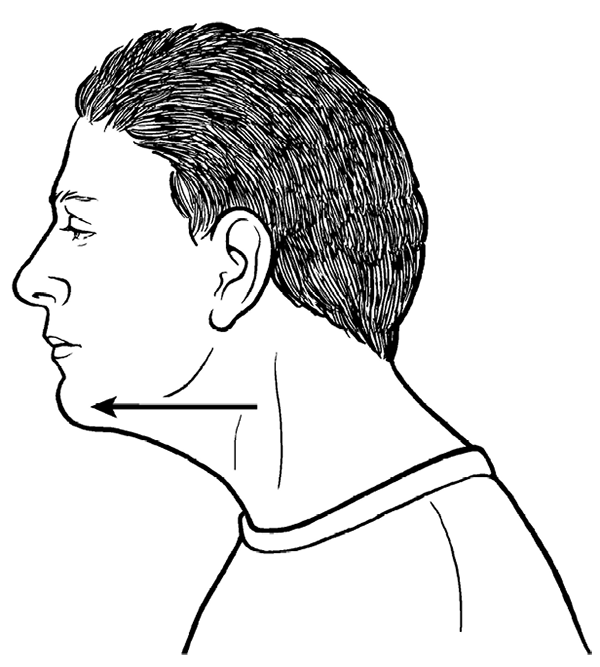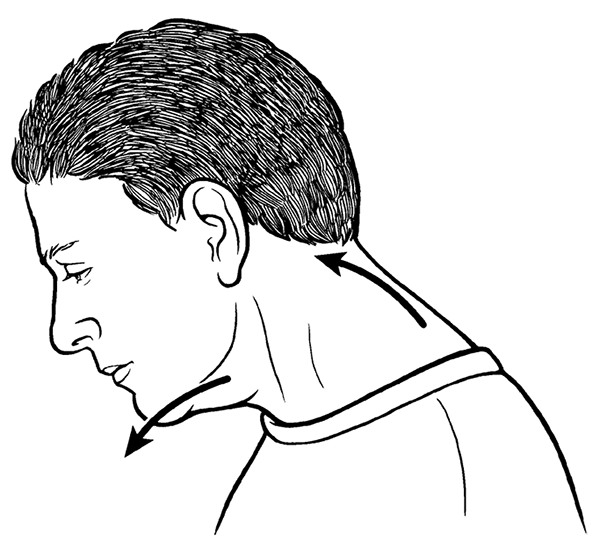Chinese Healing Exercises (21 page)
Read Chinese Healing Exercises Online
Authors: Steven Cardoza
Tags: #Taiji, #Qi Gong, #Daoist yoga, #Chinese Healing, #Health, #medicine, #remedy, #energy

If your hip rotators or low back are very tight, you may not be able to increase the stretch at all in the beginning. In that case, just hold your starting position, and breath as directed above without trying to increase the stretch.
Do
try to become more relaxed and release whatever tension you may feel, especially focusing on the exhales to best accomplish that. As you are able to increase the relaxation and release, you will find that you can begin to increase the stretch.
Variation
If you're unable to get into the full starting position but can get your legs close, try this variation. Once you're seated properly, grasp your left knee with your right hand, right fingers curling around the knee, and place your left hand on top of your right. Then gently pull your knee to the right with your right hand, while pushing with the left
(
Fig 6.12
).
This will move your knee to the right and your torso to the left as in the original exercise, but is a bit easier, you may increase the stretch in smaller increments, and you will be less able to
overturn and overstretch, a built-in safeguard against doing too much. Use your breath to
relax into this stretch as directed above. Repeat in the opposite direction.
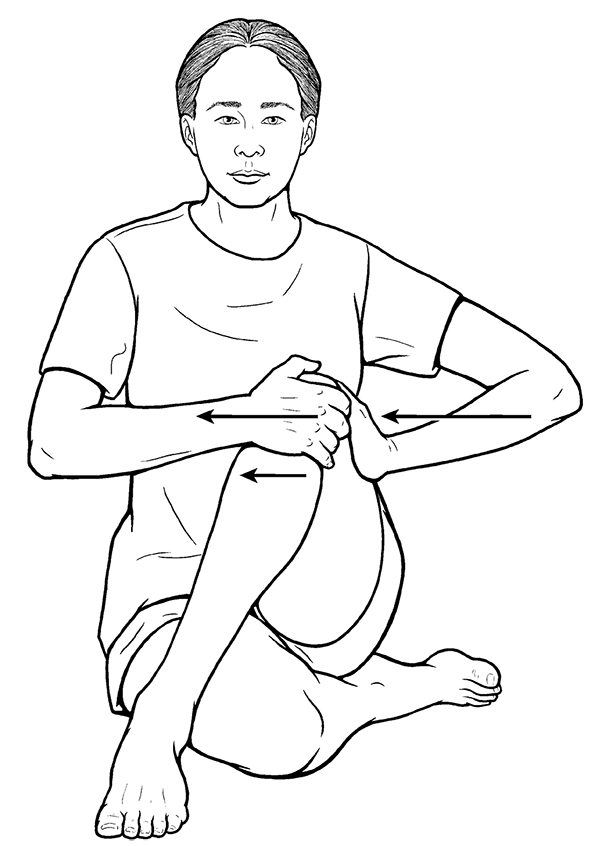 Figure 6.12 (Seated Torso Twist)
Figure 6.12 (Seated Torso Twist)
9. Lying Du Meridian Back Extension
As in the previous exercise, this has a counterpart in Hatha yoga: the Cobra pose. There are other ways to do back extensions, standing variations, but lying down offers more protection for an injured or weak back, and less chance of injury than in standing variations. It also mimics the way we first activated our Du meridian as babies.
The Du meridian is one of the Eight Extra (Extraordinary) meridians. While all meridians form during embryonic development, the Eight Extra meridians are believed to only fully activate sometime after birth. The physical activity a baby engages in to both promote and reflect the activation of the Du meridian involves gradually pushing him- or herself toward an upright position. First, the upper part of the back activates, near the base of the neck, at the acupoint Du 14, and the baby raises his or her head. Soon after, the lower back is activated, near the point Du 4, and the baby arches his or her back, pushing itself up, elongating the paravertebral muscles and spine. You'll see that this exercises mirrors that process exactly. In a baby, this instinctive behavior is the physical manifestation of perceptual and psychological states, the lifting of the head allowing the baby to look toward the horizon, establishing an initial goal. Once the goal is seen, the baby develops the posture to move toward that goal. In very goal-oriented adults, this can be a causative factor in stiff necks and low back pain from doing too much. None of the other back exercises taught here involve extension, so they all will counterbalance that tendency. Done gently, back extensions can unlock those stiff areas in different ways and provide other benefits as well.
Purpose
Physical:
Opens the front of the spine, elongates the paraspinal muscles (the muscles that are at either side of the vertebral column), massages the kidneys and adrenals, may improve general and sexual vitality.
Energetic:
Stimulates qi flow through both the Du and Ren meridians, and secondarily the Urinary Bladder, Kidney, Stomach, Spleen, and Liver meridians. The Du meridian governs the body's Yang qi, and the Ren governs the Yin qi. They overlay the Microcosmic Orbit, which has a harmonizing effect on the whole body; the energetic benefits are far-reaching.
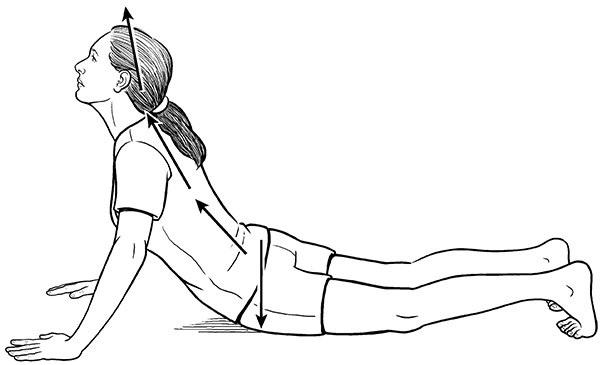 Figure 6.13 (Lying Du Meridian Back Extension)
Figure 6.13 (Lying Du Meridian Back Extension)
Techniques used
Stretching, back extension, focused breathing.
Method
Lie face down on the ground, with your palms down directly under or slightly in front of your shoulders, as though you were about to do pushups. Your toes can be pointing straight back or curled so that the toe pads are touching the ground. Lift your head so that you are looking straight forward. Then on an exhalation, push up with your hands and arms, and only gently engage your low back muscles to arch your back. Make sure you support your weight with your hands and arms throughout, as this will prevent the possibility of back strain. Keep your pelvis in contact with the ground, which will increase the rearward bend in your low back. Feel a lengthening of your entire spine, from your tailbone to the top of your head. If you feel a compression in your back, press your hands a little more strongly into the ground to try to lengthen your spine and reduce the compression
(
Fig 6.13
).
If you are not able to do that, you may need to lower your chest slightly closer to the ground, only to the point where the compression disappears. If you are able, arch your back far enough to be able to look straight up to the sky. You may feel a stretch along the front of your belly. That is both normal and beneficial. At whatever point you reach your limit of extension, take a few slow, deep breaths. Breathe into any area of restriction, and on the exhalation, try to relax and release it. You may be able to increase your extension after a few exhalations. Hold this posture for five to ten breaths, and then lower yourself back to your starting position on an exhalation. Repeat three times.
Seven
Neck
The next series of exercises focuses on the neck. The health of the neck is extremely important. Throughout the whole waking day, your neck supports the weight of your head and holds it upright. This is a little more challenging for people who sit at a desk for most of their work or school day, with their head inclined forward looking at a computer screen or doing paperwork, since the neck vertebrae are put out of optimal alignment and the neck muscles are forced to work harder for long parts of the day, every day.
The neck is the connecting pathway between your head and the rest of your body. This means it's involved with the exchange of blood into and out of your head, including your brain, sense organs, and all your facial and scalp muscles. Any physical obstruction or restriction can reduce blood flow, impairing cognition, perception, and expression. Poor venous return, blood leaving the head to return to the heart, can increase the pressure inside the head and cause headaches, increase the concentration of metabolic and acquired waste products in the head, and set the stage for strokes. All the spinal nerves pass through the neck, from the brain to govern various functions of the body, and to the brain to relay information about the condition of the body and numerous environmental factors. Reduced nerve impulse transmission through the neck can impair the function of organs and muscles, and diminish sensory input so that various physical warning signs or dangers may go unnoticed. Virtually all acupuncture meridians pass through the neck, including seven of the Eight Extraordinary meridians and the core constitutional channels. While only the Yang, Du, and Ren meridians have external pathways through the neck and into the head, capable of being needled in acupuncture treatments, the Yin meridians have direct and indirect internal pathways there. The other neck and head Extraordinary meridians can only be needled through their associations with the regular meridians. As all of those meridians benefit from these exercises; the energetics are too extensive to list here individually.
Neck pain, which is almost always accompanied by upper back and shoulder pain, is epidemic in our culture, as are headaches. They may be the obvious result of traumatic injury, but otherwise physiologically, they may indicate muscle spasm, nerve impingement, or both, and cause or result from inflammation or other irritating factors, including mental and emotional stress. Arteries are muscular and are implicated in some types of headaches when they spasm within the head. Any type of spasm reduces blood flow, diminishing nourishment to the affected and surrounding muscles and allowing toxic waste to accumulate. This is one aspect of what the Chinese refer to as Blood Stagnation. In the absence of trauma, Blood Stagnation is usually a complication of prolonged Qi Stagnation, so attending to the associated energetics even before trouble is noticed is always a wise precaution. As with back pain, the narrowing of space between vertebrae and the degeneration of the vertebral bones may be involved. Most people naturally avoid anything that triggers pain, and often in the case of neck pain, especially chronic neck pain, that means reducing mobility. Reduced mobility eventually reduces functionality, which leads to further reduced mobility. So, while neck and shoulder pain may seem to mainly be common, troublesome nuisances, they are frequently the early stages of more serious complications if left untreated.
Most of these exercises utilize bending and stretching, flexion and extension, rotation, or combinations of those. Unless otherwise noted, they don't involve held stretches, so focused breathing is optional. The main concern with breath throughout this series is that the breath should never be held. As a reminder, that's true for all the exercises in this book. The entire series should not take much time, and ideally every exercise should be performed. The purpose of each is to maintain or improve the functionality of the neck and prevent or reduce pain, and to facilitate the transmission of nerve impulses and flows of blood and qi into and out of the head, for the reasons outlined above. It is common and normal to feel and hear popping and/or crunching sounds as you perform these exercises. The medical name for that is crepitus. Since you will not be actively trying to “crack” your neck in any of these exercises, the sounds you may hear are not at all damaging or dangerous, and in fact most often reduce over time with practice, indicating a healing response.
All of these exercises are best performed seated, either in a chair or on the ground, whichever is most comfortable. In terms of the seated posture, the most important thing is to keep your back straight. Slouching is counterproductive, since it creates a misalignment of the vertebrae of your back, which is the foundation upon which your neck rests. If you sit in a chair it should be firm, not plush, and you should sit on the forward half to the forward third of the seat. This will help keep your back straight. Do not lean on any seat back unless you have a serious back problem that requires that support. Place your hands on your knees, and let the weight of your arms comfortably pull your shoulders downward, helping to release any tension there. If you sit on the ground, either directly or on a cushion, make sure part of your focus is maintained on keeping your back straight. You may place your hands on your knees or keep them folded in your lap. Keeping your back straight also means that your shoulders and torso want to remain stationary, facing straight forward. In these exercises, we want to specifically target the neck, and for that to happen most effectively,
only
the neck should move.
Breathe comfortably, slowly, fully, and deeply, with no held breath at the end of either the inhale or exhale, and no place in between. From this starting posture, begin the neck exercises.
1. Flex and Extend
This simple exercise is always a good place to begin the neck exercises. It helps to loosen the neck vertebrae, soften the muscles, and increase regional blood flow, and prepares the neck for what comes later.
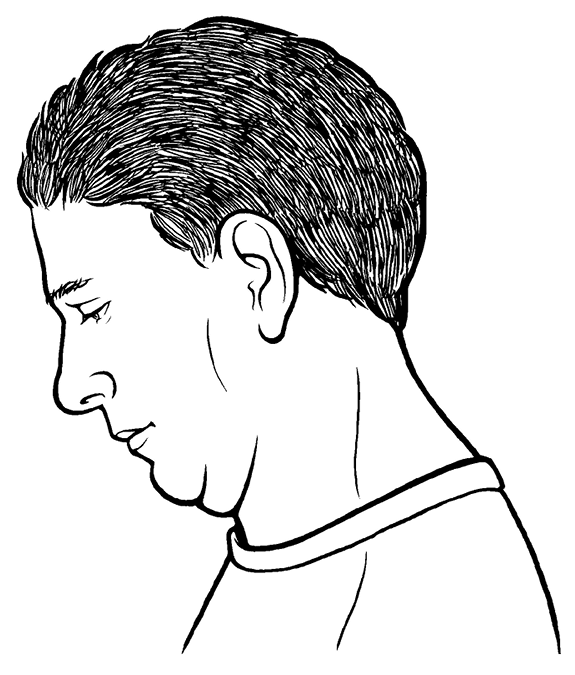
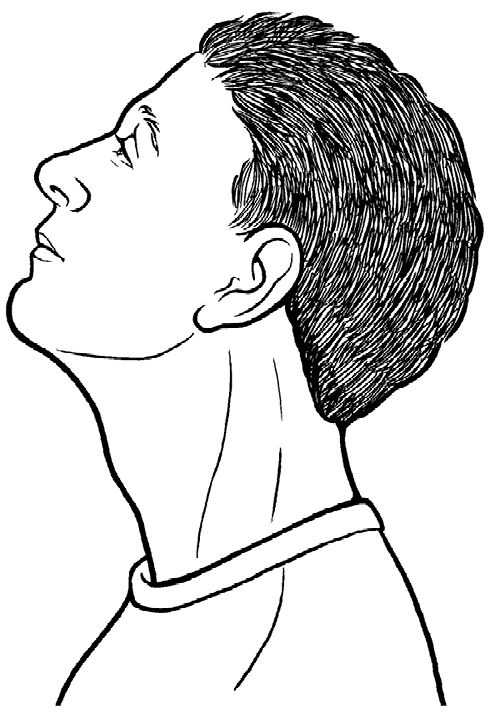
Figures 7.1A and 7.1B (Flex and Extend)
Keep your head facing straight forward, not turning to one side or the other, and carefully drop your chin toward your chest, as though you were nodding “yes.” Let the weight of your head stretch your neck forward as far as it will go, but do not force it farther forward than that
(
Fig 7.1A
).
As your neck opens over time, the natural final end point will be when your chin actually touches your chest. Then raise your head to its starting position, and slowly tilt it backward some to look toward the sky
(
Fig 7.1B
).
This backward extension should be limited, not as full as you might be able to move your neck. That's because there are parts of the vertebraeâthe spinous processesâthat extend to the back of your neck, and they can get jammed together if you tilt your head back too forcefully or too far. In neigong practices, you may learn to increase the space between the vertebrae, which will safely allow a greater extension, but outside of that circumstance the neck is not structurally designed to extend far. A relatively slight extension is fine for this exercise.
Repeat this forward bend and backward extension ten to twelve times, slowly and purposefully, with no jarring at the ends of the bend in either direction. Breathe comfortably and naturally throughout. Return your head to its starting position and begin the next exercise.
2. Turtle
The Turtle naturally picks up where Flex and Extend ends. This exercise creates a glide, the motion of each vertebra sliding forward and back over its neighbors.
With your head fully upright and facing forward, stick your chin out as far as your neck allows, keeping your jaw as close to parallel to the ground as possible
(
Fig 7.2A
).
Feel the glide between the neck vertebrae, possibly extending into your upper back. This looks a bit like a turtle sticking its head out of its shell. Then, still facing forward and keeping your jaw parallel to the ground, withdraw your chin as far back as you can, tucking it in toward your neck
(
Fig 7.2B
).
You may feel or encourage a slight corresponding rise of the top of your head toward the sky. The chin tuck and rise of the head opens the back of the neck. Repeat this ten to twelve times, then return your head to its starting position and begin the next exercise.
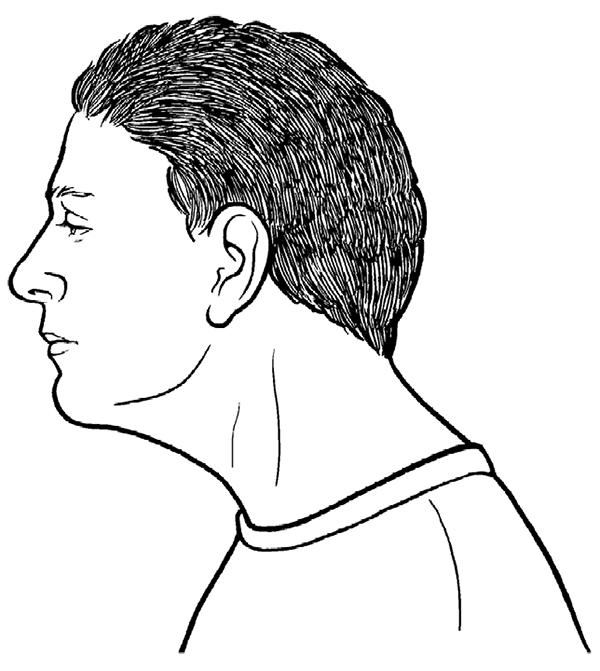
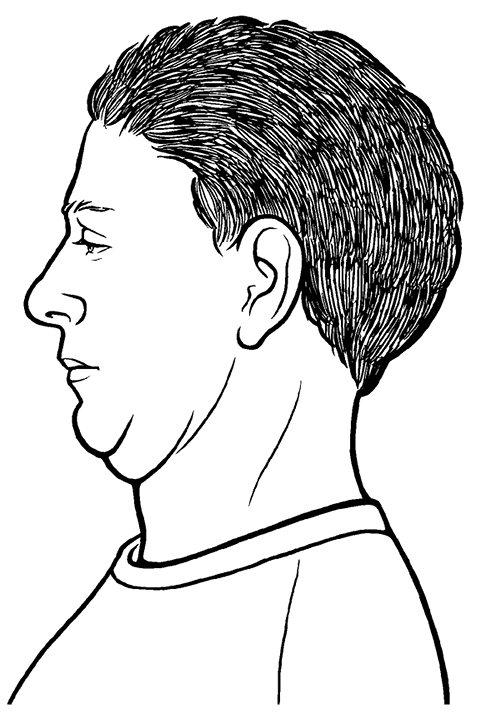
Figures 7.2A and 7.2B (Turtle)
3. Crane
The Crane completes the set of three forward neck bends. Ideally, you should practice all three whenever you do these neck exercises.
Begin as though you were doing the Turtle, sticking your chin out as far as your neck allows, keeping your jaw as close to parallel to the ground as possible
(
Fig 7.3A
).
Then, with your neck fully protracted (chin jutting forward), bend your neck forward as if you were wrapping the front of your neck around a ball under your chin
(
Fig 7.3B
).
Keep your chin as close to your body as you can, making sure you don't drop the imaginary ball you are holding as you pull it up the front of your neck with your chin
(
Fig 7.3C
).
Feel the back of your neck extending and your whole neck unfurl as you gradually return your head to a fully upright position. At the end of the unfurl, give a little extra lift to your head, extending it straight up toward the sky. Repeat ten to twelve times.
